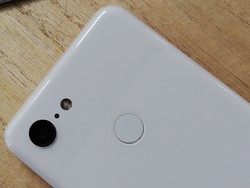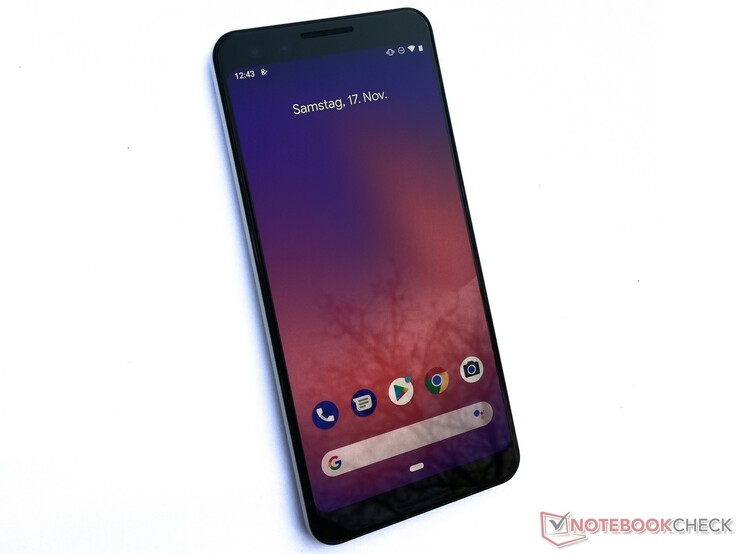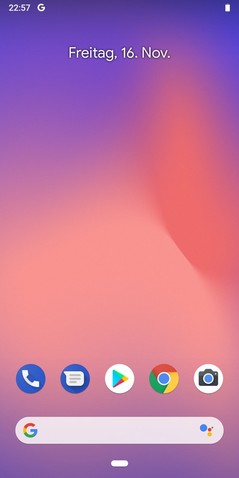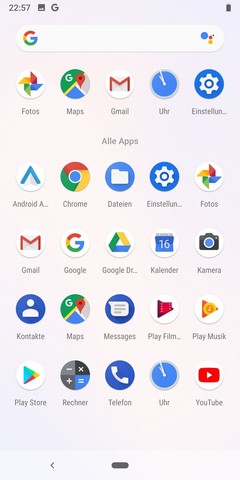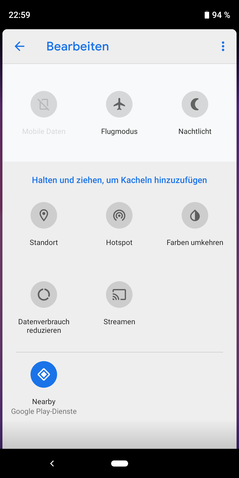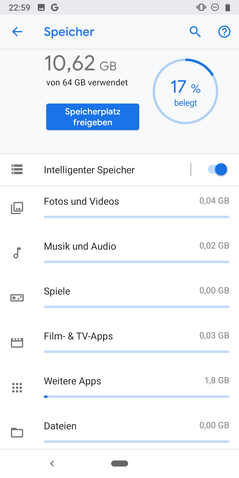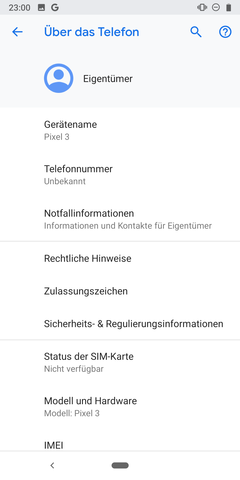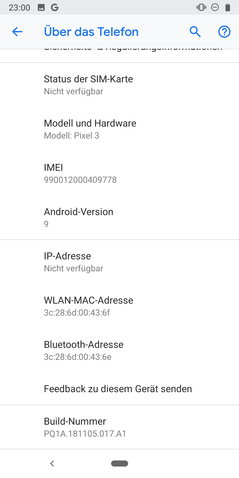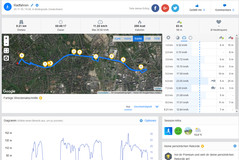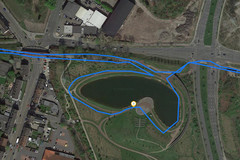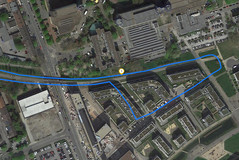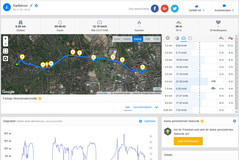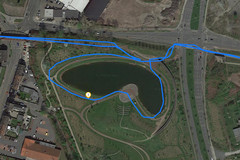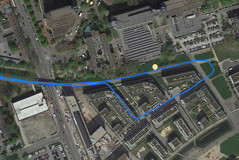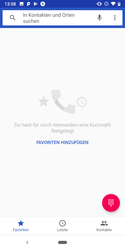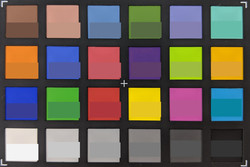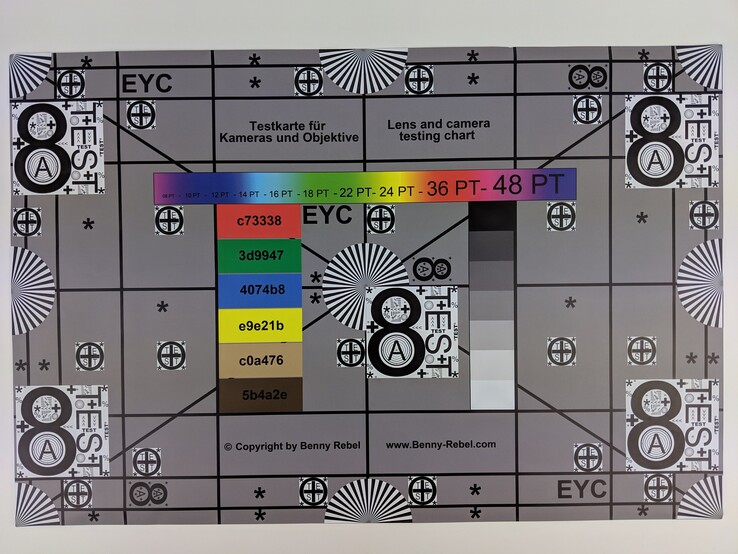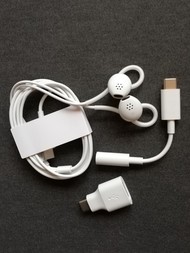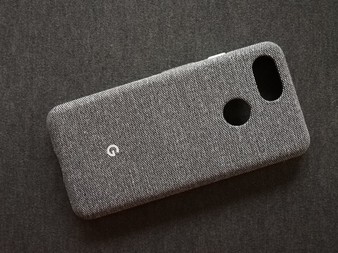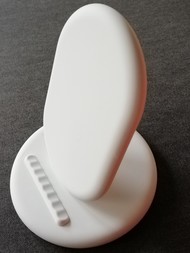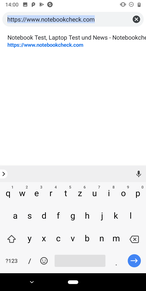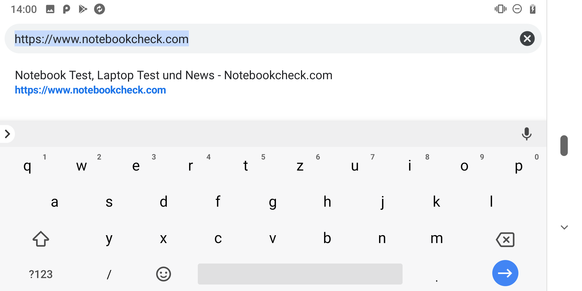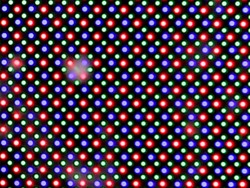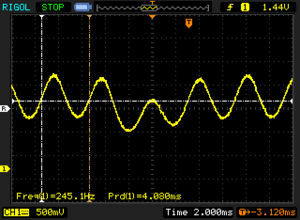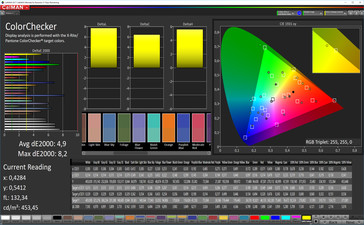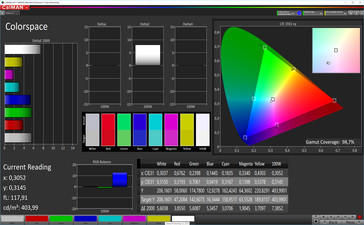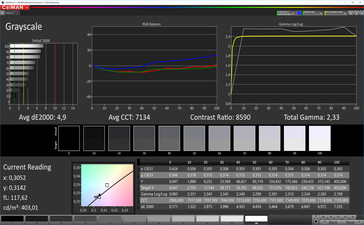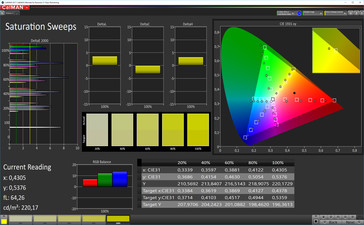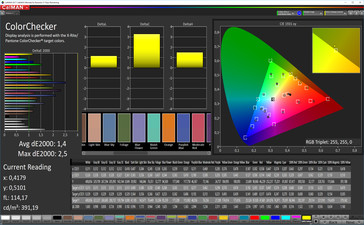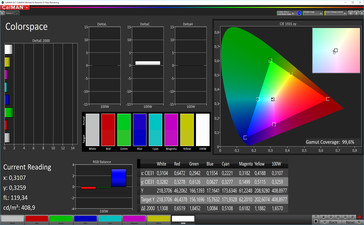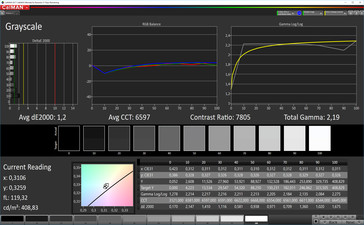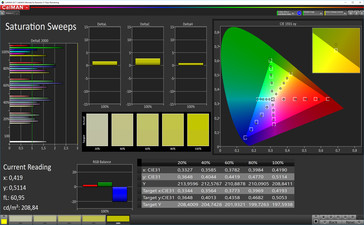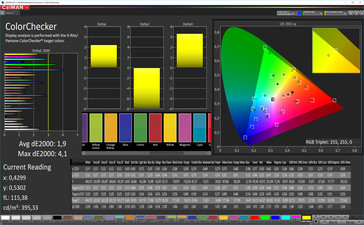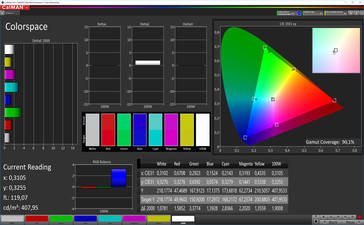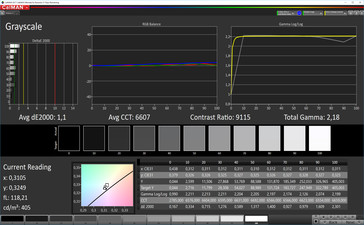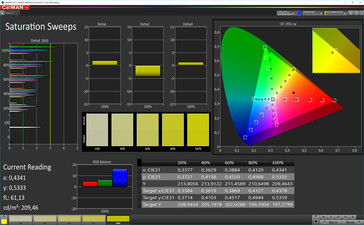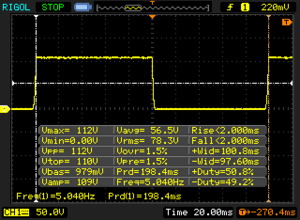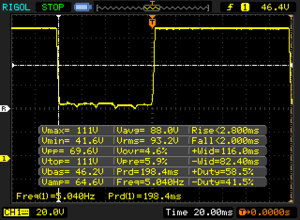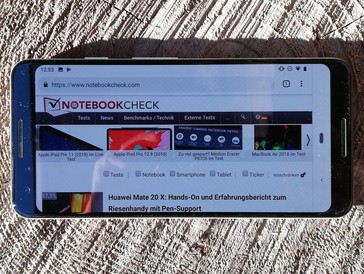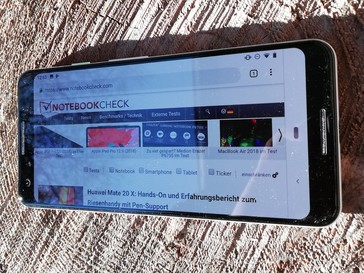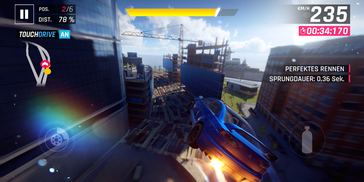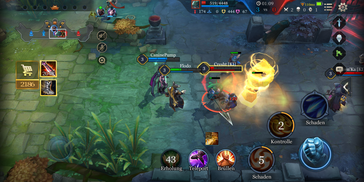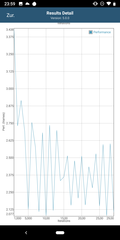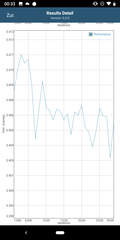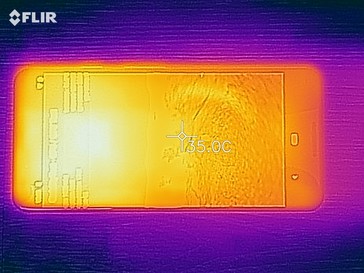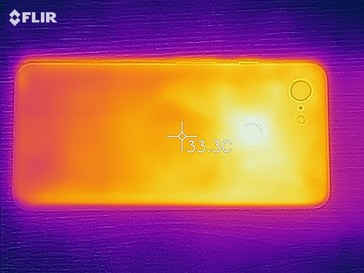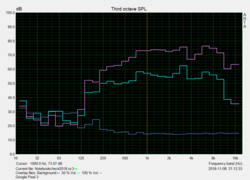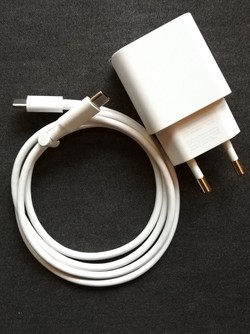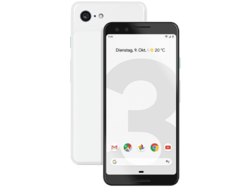Google Pixel 3 Smartphone Review
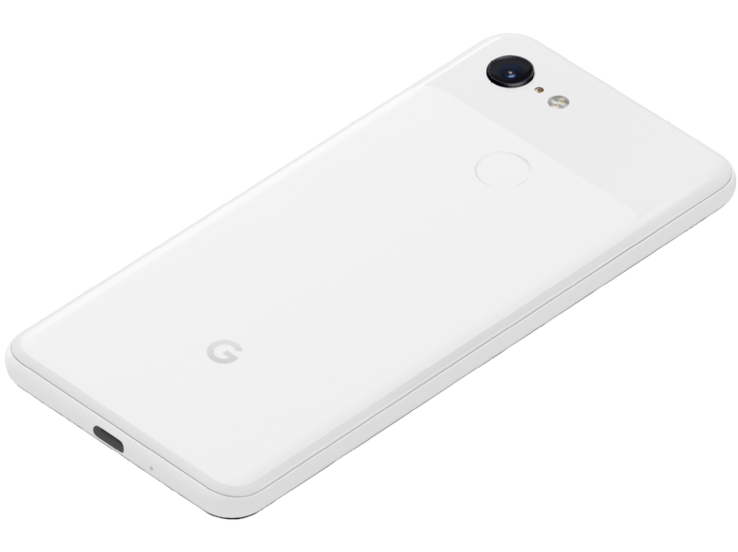
While last year’s Pixel 2 looked like its predecessor, Google has subtly adjusted the design of this year’s Pixel 3. The display has increased by 0.5-inches to 5.5-inches and the aspect ratio has changed to the increasingly popular 2:1. Google has also equipped the Pixel 3 with a Qualcomm Snapdragon 845 SoC that integrates an Adreno 630 GPU, 4 GB RAM and 64 GB of UFS 2.1 flash storage. The company sells a 128 GB version too, although no models have dual-SIM functionality or expandable storage.
The Pixel 3 currently retails at US$799 (£739), which puts it in the firing line against other flagship devices from Apple, HTC, Huawei, LG, Samsung and Sony among others. We have chosen to compare the Pixel 3 against the Apple iPhone XS, the HTC U12 Plus, the Huawei P20 Pro and the Sony Xperia XZ3. The Pixel 3 is currently more expensive than all but the iPhone XS of our comparison devices, the latter of which is several hundred dollars more expensive than Google’s latest small flagship.
Case
The Pixel 3 has an aluminum unibody frame that Google has sandwiched between two pieces of Corning Gorilla Glass 5. The company refers to the back glass as being ‘soft touch’, which essentially means that it has a frosted finish. The fingerprint sensor remains on the back case, but it has lost the metallic ring around it that Google used on the Pixel 2. The physical buttons sit firmly within the frame and the quality of our test device is great overall. However, we can feel a small gap around the SIM card slot, which is a shame.
The display has rather thick bezels that we measure at around 8 mm (~0.31-inches), which make the device look outdated compared to its contemporary competitors. The Pixel 3 comes in a choice of ‘Clearly White’, ‘Just Black’ or ‘Not Pink’, all of which are IP68 certified against dust and water.
Connectivity
The Pixel 3 is powered by a Qualcomm Snapdragon 845 SoC, which integrates an Adreno 630 GPU. The Snapdragon 845 remains Qualcomm’s flagship SoC at the time of writing, although we expect the company to announce the Snapdragon 8150 within the next few weeks. Google has complemented the powerful SoC with 4 GB RAM and 64GB of UFS 2.1 flash storage, the latter of which should be large enough for most users.
The Pixel 3 also has a USB 3.1 Type-C port, which is the only port on the device. There is an NFC chip too for use with Google Pay and other NFC-based services, and Bluetooth 5.0, which supports aptX and aptX HD. We did not expect Google to reintroduce the headphone jack, but the company has brought back Qi wireless charging support, which is a useful addition.
Software
The Pixel 3 ships with Android 9.0 Pie, while our test device arrived with the November 5, 2018, Android security patch. Google has guaranteed that the device will receive security and system updates until at least 2021.
Our test device only has Google apps pre-installed, which is always a refreshing change from the bloatware that most manufacturers pre-install on their devices. The Pixel 3 supports multi-user accounts should more than one person need to use the device. Google also includes unlimited cloud storage until January 31, 2022, for every Pixel 3 purchase. The company has stated that the data will remain on Google servers after that date, but we suspect people will have to pay to keep their data on the Google Cloud after that date. The Pixel 3 comes with other useful features too like music recognition, the Google AR Playground and Google Lens.
Communication & GPS
The Pixel 3 supports GSM, 3G and LTE mobile networks. The latter functions at Cat.16, which can achieve up to 1 Gbit/s download and 75 Mbit/s upload speeds. Google promises that the device will work on LTE networks worldwide thanks to its 4x4 MIMO antenna. The device has not only one nano-SIM slot but also an eSIM that is soldered to the motherboard.
The device supports all modern Wi-Fi standards up to IEEE 802.11 ac and can connect to 2.4 GHz or 5 GHz networks. Our test device achieved class beating transfer speeds in our iperf3 Client Wi-Fi tests, which are marginally ahead of the iPhone XS.
| Networking | |
| iperf3 transmit AX12 | |
| Google Pixel 3 | |
| Apple iPhone XS | |
| HTC U12 Plus | |
| Sony Xperia XZ3 | |
| Huawei P20 Pro | |
| iperf3 receive AX12 | |
| Google Pixel 3 | |
| Apple iPhone XS | |
| Huawei P20 Pro | |
| Sony Xperia XZ3 | |
| HTC U12 Plus | |
The Pixel 3 uses BeiDou, Galileo, GLONASS, and GPS for location services, the accuracy of which we tested with the GPS Test app. Our test device achieves a satellite fix with an accuracy of up to three meters (~10 feet) when tested outside, but it could not find a fix indoors.
We also took our test device on a bike ride to compare its navigation accuracy against a professional navigation device, the Garmin Edge 500. The Pixel 3 plotted a 50 m (164 feet) shorter route than the 5.51 km (3.42 miles) route that the Garmin recorded us having cycled. The Pixel 3 could not maintain the same accuracy through corners as the Garmin could, which resulted in corners looking choppier in our included photos. Overall, the Pixel 3 is accurate enough even for precise navigation tasks as its accuracy improved significantly when we rode slower.
Telephone Features & Call Quality
The Pixel 3 expectedly uses the standard Google Phone app to handle calls and to store contacts. The app functions just as well on our test device as it does on any other modern smartphone.
Our test device has impressive call quality and reliably filtered out background noise throughout testing. The earpiece gets loud enough to make calls even from noisy environments.
The Pixel 3 also supports Google Duplex, a feature that Google demonstrated at its keynote. Google Duplex allows Google Assistant to make or receive calls if you are busy, almost like a digital personal assistant. Google Duplex records the conversation, which can be subsequently played back. Alternatively, people can read a transcript instead. Unfortunately, Google had only rolled out the software to the US at the time of writing, so we could not test its functionality in Germany.
Cameras
The Pixel 3 has dual 8 MP front-facing cameras and a single 12 MP rear-facing sensor that has an f/1.8 aperture. The secondary front-facing sensor has an ultra-wide lens that Google advertises is useful for taking group selfies. Both front-facing sensors take detailed photos that capture fine structures like hair strands and do not artificially blur background imagery. The default camera uses a ‘Retouch’ feature by default, which makes faces look too soft and warm for our liking. Thankfully, its effect can be reduced or switched off. The camera lacks a professional or manual mode, but there are options for adjusting ambient light, white balance and HDR.
The rear-facing camera takes decent photos with vivid colors, albeit colors tend to look slightly darker than they should do. Objects and people are always captured sharply though and are neither obscured in dark areas nor are they overblown in bright areas. Macro shots look better in our opinion, primarily because colors appear more balanced and objects look noticeably sharper. The camera captures fine structures well too. Moreover, Bokeh effects look great and do not contain many artifacts. The default camera app also supports a feature called ‘Top Shot’ too. ‘Top Shot’ uses machine learning to take several photos before and after the shutter is pressed, which allows people to pick the best shot rather than needing to retake a photo.
The main camera’s real strength is in low light, particularly ‘Night Sight’ or ‘Night’ mode. The feature works with all three cameras and dramatically improves the exposure of low-light pictures by taking several photos at different exposures and then stitching them together. The difference in detail captured is striking, as shown in our third comparison picture below. The Pixel 3 cannot compete with a Canon EOS 70 D for image clarity, but our test device takes a noticeably better low light photo than either the iPhone XR or the P20 Pro.
Videos also generally look as good as photos. The default camera can record video in up to 4K at 30 FPS, which is encoded in H.264/ACV by default. However, there is a setting that enables H.265/HEVC encoding, which takes up much less space than H.264 videos. There is no professional mode, but the default camera mode has multiple options for different lighting conditions and can deactivate image stabilization should you need to. There is also a ‘motion’ function that does a good job at keeping moving objects in focus.
We also subjected the Pixel 3 to further camera tests under controlled lighting conditions with ColorChecker Passport. Our test device generally reproduces colors too brightly compared to the reference color, while dark gray and black tones look too dark.
Our test device captured our test chart in detail though. The resulting photo is clear and fine structures are visible, although colors look too dark for our liking. The bottom corners are also paler than the rest of the image, but this did not occur during our other test shots.
Accessories & Warranty
Google includes a USB Type-C charger in the box with a matching USB Type-C cable, a 3.5 mm to Type-C adapter, a Type-A to Type-C adapter and a SIM tool.
The company has also introduced a wireless charger called the Pixel Stand, which automatically puts the Pixel 3 into do not disturb mode when the device is locked. The Pixel Stand uses the Qi standard to recharge our test device fully in around two hours. The company sells two types of cases too, one that has a fabric finish and the other that Google calls ‘My Case’. The latter features designs by artists like Heather Day and Hebru Brantley among other options. Our gray fabric case fitted our test device perfectly. Finally, the Pixel 3 works with the Daydream View VR mount and the Google Pixel Buds. We have included the prices for all these accessories below. The Pixel 3 comes with two years manufacturer’s warranty too. Please see our Guarantees, Return policies and Warranties FAQ for country-specific information.
| Accessory | Price US | Price UK |
|---|---|---|
| Pixel Stand | $89.99 | £69 |
| Pixel 3 Case | $40 | £35 |
| My Case | $50 | £40 |
| Daydream View | $99 | £99 |
| Pixel Buds | $159 | £159 |
Input Devices & Operation
The Pixel 3 predictably uses Google Gboard as its default keyboard. The keyboard works just as well as it does on other devices. The touchscreen on our test device reliably reproduced our inputs quickly throughout testing. The display has a smooth finish too, on which it is easy to execute multi-finger gestures. The position sensor and fingerprint sensor worked consistently too during our tests.
Google has continued to include its Active Edge technology, which can trigger actions like launching Google Assistant when the bottom third of the device is squeezed. The activation force can be customized in Settings. We had to press our test device relatively hard even on the most sensitive setting to activate Active Edge, so we doubt that people will trigger the feature accidentally in daily use.
Display
The Pixel 3 has a notchless 5.5-inch OLED display that runs at a native 2,160 x 1,080 resolution in a 2:1 aspect ratio. Our test device achieves an average maximum brightness of 398 cd/m² according to X-Rite i1Pro 2, which is well below the maximum luminosities of our comparison devices. It is also slightly behind the maximum brightness that its predecessor achieved in our tests. The display is 91% evenly lit though, which is only a few percent behind that of our best comparison devices.
The device is also UHDR certified, which means that it can natively display HDR content. We do measure a pulse-width modulation (PWM) frequency of 245 Hz though, which could cause eye strain and headaches for those who are PWM sensitive.
| |||||||||||||||||||||||||
Brightness Distribution: 91 %
Center on Battery: 393 cd/m²
Contrast: ∞:1 (Black: 0 cd/m²)
ΔE ColorChecker Calman: 1.4 | ∀{0.5-29.43 Ø4.78}
ΔE Greyscale Calman: 1.2 | ∀{0.09-98 Ø5}
99.6% sRGB (Calman 2D)
Gamma: 2.19
CCT: 6597 K
| Google Pixel 3 OLED, 2160x1080, 5.5" | Huawei P20 Pro OLED, 2240x1080, 6.1" | Apple iPhone XS OLED, 2436x1125, 5.8" | Sony Xperia XZ3 OLED, 2880x1440, 6" | HTC U12 Plus Super LCD 6, 2880x1440, 6" | |
|---|---|---|---|---|---|
| Screen | 14% | 14% | -155% | -7% | |
| Brightness middle (cd/m²) | 393 | 569 45% | 639 63% | 543 38% | 395 1% |
| Brightness (cd/m²) | 398 | 578 45% | 637 60% | 542 36% | 402 1% |
| Brightness Distribution (%) | 91 | 95 4% | 94 3% | 92 1% | 90 -1% |
| Black Level * (cd/m²) | 0.37 | ||||
| Colorchecker dE 2000 * | 1.4 | 1.3 7% | 1 29% | 6.6 -371% | 1.6 -14% |
| Colorchecker dE 2000 max. * | 2.5 | 2.1 16% | 2.2 12% | 11 -340% | 3.4 -36% |
| Greyscale dE 2000 * | 1.2 | 1.6 -33% | 2.2 -83% | 4.7 -292% | 1.1 8% |
| Gamma | 2.19 100% | 2.31 95% | 1.9 116% | 1.835 120% | 2.14 103% |
| CCT | 6597 99% | 6401 102% | 6364 102% | 6817 95% | 6536 99% |
| Contrast (:1) | 1068 |
* ... smaller is better
Screen Flickering / PWM (Pulse-Width Modulation)
| Screen flickering / PWM detected | 245.1 Hz | ||
The display backlight flickers at 245.1 Hz (worst case, e.g., utilizing PWM) . The frequency of 245.1 Hz is relatively low, so sensitive users will likely notice flickering and experience eyestrain at the stated brightness setting and below. In comparison: 53 % of all tested devices do not use PWM to dim the display. If PWM was detected, an average of 8111 (minimum: 5 - maximum: 343500) Hz was measured. | |||
OLED displays can individually switch off pixels to create, at least theoretically, absolute blacks. This also resulted in an infinite contrast ratio, which Google refers to as being 100,000:1.
The Pixel 3 also has three display color profiles, ‘Adaptive’, ‘Normal’ and ‘Vivid’. Google sets the display to ‘Adaptive’ by default, which gives our test device a slight blue tint and makes colors look rather cool. The ‘Natural’ profile alters the blue cast somewhat, while ‘Vivid’ mode delivers punchier colors overall. There is also a night mode that makes the color temperature warmer to help reduce eye strain at night, the intensity of which can be adjusted manually.
Display Response Times
| ↔ Response Time Black to White | ||
|---|---|---|
| 4 ms ... rise ↗ and fall ↘ combined | ↗ 2 ms rise | |
| ↘ 2 ms fall | ||
| The screen shows very fast response rates in our tests and should be very well suited for fast-paced gaming. In comparison, all tested devices range from 0.1 (minimum) to 240 (maximum) ms. » 15 % of all devices are better. This means that the measured response time is better than the average of all tested devices (20.2 ms). | ||
| ↔ Response Time 50% Grey to 80% Grey | ||
| 4.8 ms ... rise ↗ and fall ↘ combined | ↗ 2.8 ms rise | |
| ↘ 2 ms fall | ||
| The screen shows very fast response rates in our tests and should be very well suited for fast-paced gaming. In comparison, all tested devices range from 0.165 (minimum) to 636 (maximum) ms. » 15 % of all devices are better. This means that the measured response time is better than the average of all tested devices (31.6 ms). | ||
Our test device gets bright enough to use outside, although reflections can obscure what is being displayed onscreen. This can also happen when sitting under bright indoor lighting, but the Pixel 3’s comparatively low maximum brightness should not be an issue in daily use other than when using the device in bright direct sunlight.
Performance
Google has equipped the Pixel 3 with a Qualcomm Snapdragon 845 SoC that integrates an Adreno 630 GPU, 4 GB RAM and 64 GB of UFS 2.1 flash storage. In short, the device is powerful enough for all modern applications, although it has less RAM than some of its competitors like the OnePlus 6T or the P20 Pro. 2 GB/4 GB less RAM may not make much of a difference in daily use now, but it could prove to be a bottleneck in a few years as apps become more resource intensive.
Our test device finished mostly in the middle of our benchmark comparison tables. The Pixel 3 outscored our comparison devices in Geekbench Compute RenderScript and in PCMark Work 2.0 but struggled comparatively in the offscreen portion of GFXBench 3.0 Manhattan, in which it finished bottom of our comparison table. Overall, the Snapdragon 845 in our test device outperforms the average of Snapdragon 845 powered devices that we have currently tested.
| PCMark for Android | |
| Work performance score (sort by value) | |
| Google Pixel 3 | |
| Huawei P20 Pro | |
| Sony Xperia XZ3 | |
| HTC U12 Plus | |
| Average Qualcomm Snapdragon 845 (7998 - 13211, n=26) | |
| Work 2.0 performance score (sort by value) | |
| Google Pixel 3 | |
| Huawei P20 Pro | |
| Sony Xperia XZ3 | |
| HTC U12 Plus | |
| Average Qualcomm Snapdragon 845 (7360 - 9868, n=27) | |
| GFXBench 3.0 | |
| on screen Manhattan Onscreen OGL (sort by value) | |
| Google Pixel 3 | |
| Huawei P20 Pro | |
| Apple iPhone XS | |
| Sony Xperia XZ3 | |
| HTC U12 Plus | |
| Average Qualcomm Snapdragon 845 (33 - 75, n=27) | |
| Average of class Smartphone (18 - 166, n=159, last 2 years) | |
| 1920x1080 1080p Manhattan Offscreen (sort by value) | |
| Google Pixel 3 | |
| Huawei P20 Pro | |
| Apple iPhone XS | |
| Sony Xperia XZ3 | |
| HTC U12 Plus | |
| Average Qualcomm Snapdragon 845 (54 - 83, n=27) | |
| Average of class Smartphone (12 - 606, n=157, last 2 years) | |
| GFXBench 3.1 | |
| on screen Manhattan ES 3.1 Onscreen (sort by value) | |
| Google Pixel 3 | |
| Huawei P20 Pro | |
| Apple iPhone XS | |
| Sony Xperia XZ3 | |
| HTC U12 Plus | |
| Average Qualcomm Snapdragon 845 (21 - 59, n=27) | |
| Average of class Smartphone (11 - 166, n=158, last 2 years) | |
| 1920x1080 Manhattan ES 3.1 Offscreen (sort by value) | |
| Google Pixel 3 | |
| Huawei P20 Pro | |
| Apple iPhone XS | |
| Sony Xperia XZ3 | |
| HTC U12 Plus | |
| Average Qualcomm Snapdragon 845 (32 - 61, n=28) | |
| Average of class Smartphone (8.4 - 413, n=158, last 2 years) | |
| AnTuTu v7 - Total Score (sort by value) | |
| Google Pixel 3 | |
| Huawei P20 Pro | |
| Apple iPhone XS | |
| Sony Xperia XZ3 | |
| HTC U12 Plus | |
| Average Qualcomm Snapdragon 845 (246366 - 299878, n=27) | |
| AnTuTu v6 - Total Score (sort by value) | |
| Google Pixel 3 | |
| Huawei P20 Pro | |
| Sony Xperia XZ3 | |
| HTC U12 Plus | |
| Average Qualcomm Snapdragon 845 (162183 - 242953, n=23) | |
The Pixel 3 performed as expected in browser benchmarks too and generally finished in the midfield of our comparison tables. In daily use, our test device loads websites and media content quickly on the default Chrome browser (version 70).
| JetStream 1.1 - Total Score | |
| Apple iPhone XS (Safari Mobile 12.0) | |
| Sony Xperia XZ3 (Chrome 70) | |
| HTC U12 Plus (Chrome 66) | |
| Google Pixel 3 (Chrome 70) | |
| Average Qualcomm Snapdragon 845 (22.5 - 90.9, n=25) | |
| Huawei P20 Pro (Chrome 65) | |
| Octane V2 - Total Score | |
| Average of class Smartphone (2228 - 121337, n=201, last 2 years) | |
| Apple iPhone XS (Safari Mobile 12.0) | |
| Sony Xperia XZ3 (Chrome 70) | |
| Google Pixel 3 (Chrome 70) | |
| HTC U12 Plus (Chrome 66) | |
| Average Qualcomm Snapdragon 845 (3991 - 18275, n=28) | |
| Huawei P20 Pro (Chrome 65) | |
| Mozilla Kraken 1.1 - Total | |
| Huawei P20 Pro (Chrome 65) | |
| Average Qualcomm Snapdragon 845 (2154 - 11204, n=28) | |
| HTC U12 Plus (Chrome 66) | |
| Google Pixel 3 (Chrome 70) | |
| Sony Xperia XZ3 (Chrome 70) | |
| Average of class Smartphone (257 - 28190, n=156, last 2 years) | |
| Apple iPhone XS (Safari Mobile 12.0) | |
| WebXPRT 3 - Overall | |
| Average of class Smartphone (38 - 380, n=35, last 2 years) | |
| Apple iPhone XS (Safari Mobile 12.0) | |
| HTC U12 Plus (Chrome 66) | |
| Google Pixel 3 (Chrome 70) | |
| Sony Xperia XZ3 (Chrome 70) | |
| Average Qualcomm Snapdragon 845 (19 - 103, n=17) | |
| Huawei P20 Pro (Chrome 65) | |
* ... smaller is better
Our test device also has fast storage, which outscored the class average and the average of 64 GB UFS 2.1 equipped devices that we have tested in AndroBench 3-5. The Pixel 3 finished second in our comparison table, trailing the P20 Pro by 8% overall, which is primarily because of the latter’s exemplary random write speeds.
The Pixel 3 has 52 GB of free storage when first booted. The remaining drive space is used by the OS. The device does not support expandable storage, which is a shame, although its unlimited Google Cloud storage is a useful alternative.
| Google Pixel 3 | Huawei P20 Pro | Sony Xperia XZ3 | HTC U12 Plus | Average 64 GB UFS 2.1 Flash | Average of class Smartphone | |
|---|---|---|---|---|---|---|
| AndroBench 3-5 | 8% | -24% | -11% | -8% | 337% | |
| Sequential Read 256KB (MB/s) | 766 | 832 9% | 681 -11% | 709 -7% | 696 ? -9% | 2223 ? 190% |
| Sequential Write 256KB (MB/s) | 181.8 | 196.7 8% | 196.1 8% | 195.8 8% | 224 ? 23% | 1838 ? 911% |
| Random Read 4KB (MB/s) | 149.8 | 144.3 -4% | 135.7 -9% | 118.1 -21% | 137.2 ? -8% | 295 ? 97% |
| Random Write 4KB (MB/s) | 133.8 | 160.5 20% | 22.22 -83% | 104.2 -22% | 84.7 ? -37% | 335 ? 150% |
Games
The Adreno 630 is an efficient yet powerful GPU that can handle all modern games. Our test device achieved solid frame rates in Asphalt 9: Legends and Arena of Valor, with both games averaging around 60 FPS at high graphics. It is worth bearing in mind that Asphalt 9: Legends limits frame rates to 30 FPS at minimum graphics, which is why it appears that our test device performed better at high graphics than it did at standard/low graphics.
The touchscreen and positional sensor worked perfectly and without delay throughout our games tests too.
Arena of Valor
Asphalt 9: Legends
Emissions
Temperature
The Pixel 3 manages its surface temperatures well. Our test device reaches a maximum of 30 °C (86 °F) when idle and averages a relatively cool 28.4 °C (83.12 °F). One area of the device reaches a maximum of 37 °C (98.6 °F) under sustained load, while the whole device averaged 33.5 °C (92.3 °F). In short, our test device never felt hot to the touch regardless of how hard we pushed it.
We also subjected the Pixel 3 to loops of GFXBench Battery Tests to see how well it could maintain performance when subjected to a sustained load. Our test device handled the older T-Rex benchmark well, which runs on OpenGL ES 2.0, and exhibited minor thermal throttling by the end of the benchmark loop. However, our test device thermal throttled by around 40% in the more complex Manhattan benchmark, which uses the OpenGL ES 3.1 API. This performance puts the Pixel 3’s thermal management on par with the Pocophone F1. By contrast, gaming smartphones like the ASUS ROG Phone do not thermal throttle at all in the Manhattan benchmark because of their superior cooling solutions. Most people will not notice the Pixel 3 throttling in daily use though.
(+) The maximum temperature on the upper side is 35.4 °C / 96 F, compared to the average of 35.2 °C / 95 F, ranging from 21.9 to 247 °C for the class Smartphone.
(+) The bottom heats up to a maximum of 37 °C / 99 F, compared to the average of 34 °C / 93 F
(+) In idle usage, the average temperature for the upper side is 29.2 °C / 85 F, compared to the device average of 32.9 °C / 91 F.
Speakers
The Pixel 3 has front-firing stereo speakers, which produce a balanced and comparatively loud sound. The speakers manage to reproduce deep tones without sacrificing subtle differences between mid-high tones. Ultra-high tones sometimes get lost in the mix when the speakers are operating at almost maximum volume though. Overall, Google has equipped the Pixel 3 with class-leading speakers that sound better than many of our comparison devices.
The Pixel 3 does not have a headphone jack, but Google includes a USB Type-C adapter in the box to connect traditional wired headphones to the device. The company also includes its Type-C headphones, which are rather bass heavy and lack the balanced sound that headphones that are more expensive produce. The headphones are good enough for media consumption but calls sound too muffled for our liking.
Google Pixel 3 audio analysis
(+) | speakers can play relatively loud (84.9 dB)
Bass 100 - 315 Hz
(-) | nearly no bass - on average 22.3% lower than median
(±) | linearity of bass is average (13.8% delta to prev. frequency)
Mids 400 - 2000 Hz
(+) | balanced mids - only 4.1% away from median
(+) | mids are linear (3% delta to prev. frequency)
Highs 2 - 16 kHz
(+) | balanced highs - only 4.8% away from median
(+) | highs are linear (6.9% delta to prev. frequency)
Overall 100 - 16.000 Hz
(±) | linearity of overall sound is average (17.4% difference to median)
Compared to same class
» 12% of all tested devices in this class were better, 8% similar, 80% worse
» The best had a delta of 11%, average was 35%, worst was 134%
Compared to all devices tested
» 32% of all tested devices were better, 8% similar, 60% worse
» The best had a delta of 4%, average was 24%, worst was 134%
Apple iPhone XS audio analysis
(+) | speakers can play relatively loud (87.3 dB)
Bass 100 - 315 Hz
(-) | nearly no bass - on average 17.9% lower than median
(±) | linearity of bass is average (10.3% delta to prev. frequency)
Mids 400 - 2000 Hz
(±) | higher mids - on average 5.6% higher than median
(+) | mids are linear (5.5% delta to prev. frequency)
Highs 2 - 16 kHz
(±) | higher highs - on average 8.7% higher than median
(+) | highs are linear (3.7% delta to prev. frequency)
Overall 100 - 16.000 Hz
(±) | linearity of overall sound is average (19.7% difference to median)
Compared to same class
» 30% of all tested devices in this class were better, 8% similar, 62% worse
» The best had a delta of 11%, average was 35%, worst was 134%
Compared to all devices tested
» 49% of all tested devices were better, 7% similar, 44% worse
» The best had a delta of 4%, average was 24%, worst was 134%
Battery Life
Power Consumption
The Pixel 3 is less efficient than most of our comparison devices and the average of Snapdragon 845 powered devices that we have already tested. Our test device consumes a minimum of 1.21 W at idle and a maximum of 8.79 W under load, which puts the device second bottom of our comparison table and 10% ahead of the HTC U12 Plus.
Please note, the P20 Pro appeared to power throttle significantly during our power consumption tests, so our results are not an accurate reflection of how much the device will consume in daily use. Discounting the P20 Pro, the Pixel 3 consumed around 25% and 22% more than the iPhone XS and the Xperia XZ3 on average.
Google includes an 18 W charger in the box, which is powerful enough to recharge our test device irrespective of how hard we push it. The included charger recharges our test device in less than two hours, which is around the same time as it takes the Pixel Stand to recharge the Pixel 3.
| Off / Standby | |
| Idle | |
| Load |
|
Key:
min: | |
| Google Pixel 3 2915 mAh | Huawei P20 Pro 4000 mAh | Apple iPhone XS 2658 mAh | Sony Xperia XZ3 3300 mAh | HTC U12 Plus 3500 mAh | Average Qualcomm Snapdragon 845 | Average of class Smartphone | |
|---|---|---|---|---|---|---|---|
| Power Consumption | 38% | 25% | 22% | -10% | 3% | -4% | |
| Idle Minimum * (Watt) | 1.21 | 0.84 31% | 0.95 21% | 0.8 34% | 0.77 36% | 0.862 ? 29% | 0.848 ? 30% |
| Idle Average * (Watt) | 2.01 | 1.54 23% | 1.34 33% | 1.2 40% | 2.18 -8% | 1.728 ? 14% | 1.434 ? 29% |
| Idle Maximum * (Watt) | 2.05 | 1.57 23% | 1.48 28% | 1.5 27% | 2.21 -8% | 2.07 ? -1% | 1.618 ? 21% |
| Load Average * (Watt) | 4.06 | 2.47 39% | 4 1% | 4.8 -18% | 6.25 -54% | 4.87 ? -20% | 7.01 ? -73% |
| Load Maximum * (Watt) | 8.79 | 2.49 72% | 5.13 42% | 6.2 29% | 10.16 -16% | 9.27 ? -5% | 11.3 ? -29% |
* ... smaller is better
Battery Life
The Pixel 3 has a 2,915 mAh battery, which is smaller than all but the iPhone XS of our comparison devices. Our test device finished second to the bottom of our comparison table overall, with it having an average of 8% longer runtimes than the Xperia XZ3, which finished in last place. Our test device performed well in our looped H.264 battery test, with its 12:07 runtime placing it third in our comparison table and less than an hour behind the P20 Pro with its 4,000 mAh battery. However, the Pixel 3 lasted just 2:39 in our battery life under load test, which is well behind our comparison devices.
Overall, the Pixel 3 has underwhelming battery life; it has comparatively high power consumption and a relatively smaller battery.
| Google Pixel 3 2915 mAh | Huawei P20 Pro 4000 mAh | Apple iPhone XS 2658 mAh | Sony Xperia XZ3 3300 mAh | HTC U12 Plus 3500 mAh | |
|---|---|---|---|---|---|
| Battery runtime | 52% | 20% | -9% | 5% | |
| Reader / Idle (h) | 22.9 | 28.8 26% | 24 5% | 21.2 -7% | 24.2 6% |
| H.264 (h) | 12.1 | 13.1 8% | 12.4 2% | 7 -42% | 7.7 -36% |
| WiFi v1.3 (h) | 7.9 | 12.4 57% | 9.5 20% | 7 -11% | 8.5 8% |
| Load (h) | 2.7 | 5.8 115% | 4.1 52% | 3.4 26% | 3.8 41% |
Pros
Cons
Verdict
The Google Pixel 3 is a solid high-end smartphone. It is expensive and has a dated design in our opinion, but its great rear-facing camera, pure Android experience and front-firing stereo speakers are impressive. Active Edge is a useful addition too, although its lack of customization limits its utility and prevents it from being a unique selling point.
The Pixel 3 does plenty of things well. However, the device lacks enough stand-out features to justify an $800 price tag, particularly as many of its competitors offer more for less.
Moreover, the device has a comparatively dark display and its battery life is disappointing. We hope that Google will improve this in future updates because it mars an otherwise solid flagship. The Pixel 3 does not do much to stand out from the competition, but it gets most things spot on. We would recommend the Pixel 3 for those who want the purest Android experience that money can buy, frequent updates, a class-leading rear-facing camera and excellent speakers.
Google Pixel 3
- 08/31/2022 v7 (old)
Mike Wobker




